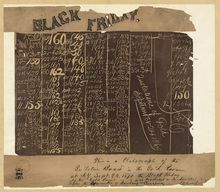Black Friday a financial panic in the United States
Photograph of the black board in the New York Gold Room, September 24, 1869, showing the collapse of the price of gold. Handwritten caption by James A. Garfieldindicates it was used as evidence before the Committee of Banking & Currency during hearings in 1870.
Black Friday, September 24, 1869 also known as the Fisk/Gould scandal, was a financial panic in the United States caused by two speculators’ efforts to corner the gold market on the New York Gold Exchange. It was one of several scandals that rocked the presidency of Ulysses S. Grant. During the reconstruction era after theAmerican Civil War, the United States government issued a large amount of money that was backed by nothing but credit. After the war ended, people commonly believed that the U.S. Government would buy back the “greenbacks” with gold.
In 1869, a group of speculators, headed by James Fisk and Jay Gould, sought to profit off this by cornering the gold market. Gould and Fisk first recruited Grant’s brother-in-law, a financier named Abel Corbin. They used Corbin to get close to Grant in social situations, where they would argue against government sale of gold, and Corbin would support their arguments. Corbin convinced Grant to appoint GeneralDaniel Butterfield as assistant Treasurer of the United States. Butterfield agreed to tip the men off when the government intended to sell gold.
In the late summer of 1869, Gould began buying large amounts of gold. This caused prices to rise and stocks to plummet. After Grant realized what had happened, the federal government sold $4 million in gold. On September 20, 1869, Gould and Fisk started hoarding gold, driving the price higher. On September 24 the premium on a gold Double Eagle (representing 0.9675 troy ounce of gold bullion at $20) was 30 percent higher than when Grant took office. But when the government gold hit the market, the premium plummeted within minutes. Investors scrambled to sell their holdings, and many of them, including Corbin, were ruined. Fisk and Gould escaped significant financial harm.
Subsequent Congressional investigation into the scandal was limited because Virginia Corbin and First Lady Julia Grant were not permitted to testify. However, Butterfield resigned from the U.S. Treasury. Henry Adams, who believed that PresidentUlysses S. Grant had tolerated, encouraged, and perhaps even participated in corruption and swindles, attacked Grant in an 1870 article entitled The New York Gold Conspiracy.
Although Grant was not directly involved in the scandal, his personal association with Gould and Fisk gave clout to their Wall Street financial gold market swindle. Also, Grant had ordered the Secretary of Treasury to release gold in order to stop the gold market manipulation. Grant had personally declined to listen to Gould's ambitious plan to corner the gold market, since the scheme was not announced publicly. Gould had promoted the plan to Grant as a means to help farmers sell a bountiful 1869 wheat crop to Europe.


No comments:
Post a Comment